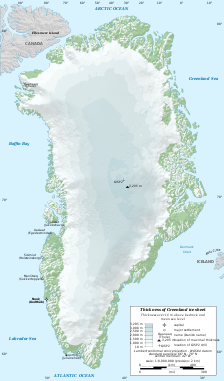Greenland ice sheet
| Greenland ice sheet | |
|---|---|

Outline map of Greenland with ice sheet depths. GISP2 refers to a main site of the Greenland Ice Sheet Project, where a 3 km (1.9 mi) deep ice core was taken.
|
|
| Type | Ice sheet |
| Coordinates | 76°42′N 41°12′W / 76.7°N 41.2°WCoordinates: 76°42′N 41°12′W / 76.7°N 41.2°W |
| Area | 1,710,000 km2 (660,000 sq mi) |
| Length | 2,400 km (1,500 mi) |
| Width | 1,100 km (680 mi) |
| Thickness | 2,000–3,000 m (6,600–9,800 ft) |
The Greenland ice sheet (Danish: Grønlands indlandsis, Greenlandic: Sermersuaq) is a vast body of ice covering 1,710,000 square kilometres (660,000 sq mi), roughly 80% of the surface of Greenland.
It is the second largest ice body in the world, after the Antarctic ice sheet. The ice sheet is almost 2,400 kilometres (1,500 mi) long in a north-south direction, and its greatest width is 1,100 kilometres (680 mi) at a latitude of 77°N, near its northern margin. The mean altitude of the ice is 2,135 metres (7,005 ft). The thickness is generally more than 2 km (1.2 mi) and over 3 km (1.9 mi) at its thickest point. It is not the only ice mass of Greenland – isolated glaciers and small ice caps cover between 76,000 and 100,000 square kilometres (29,000 and 39,000 sq mi) around the periphery. If the entire 2,850,000 cubic kilometres (684,000 cu mi) of ice were to melt, it would lead to a global sea level rise of 7.2 m (24 ft). The Greenland Ice Sheet is sometimes referred to under the term inland ice, or its Danish equivalent, indlandsis. It is also sometimes referred to as an ice cap.
The ice in the current ice sheet is as old as 110,000 years. The presence of ice-rafted sediments in deep-sea cores recovered off of northeast Greenland, in the Fram Strait, and south of Greenland indicated the more or less continuous presence of either an ice sheet or ice sheets covering significant parts of Greenland for the last 18 million years. From about 11 million years ago to 10 million years ago, the Greenland Ice Sheet was greatly reduced in size. The Greenland Ice Sheet formed in the middle Miocene by coalescence of ice caps and glaciers. There was an intensification of glaciation during the Late Pliocene.
The weight of the ice has depressed the central area of Greenland; the bedrock surface is near sea level over most of the interior of Greenland, but mountains occur around the periphery, confining the sheet along its margins. If the ice disappeared, Greenland would most probably appear as an archipelago, at least until isostasy lifted the land surface above sea level once again. The ice surface reaches its greatest altitude on two north-south elongated domes, or ridges. The southern dome reaches almost 3,000 metres (10,000 ft) at latitudes 63°–65°N; the northern dome reaches about 3,290 metres (10,800 ft) at about latitude 72°N (the fourth highest "summit" of Greenland). The crests of both domes are displaced east of the centre line of Greenland. The unconfined ice sheet does not reach the sea along a broad front anywhere in Greenland, so that no large ice shelves occur. The ice margin just reaches the sea, however, in a region of irregular topography in the area of Melville Bay southeast of Thule. Large outlet glaciers, which are restricted tongues of the ice sheet, move through bordering valleys around the periphery of Greenland to calve off into the ocean, producing the numerous icebergs that sometimes occur in North Atlantic shipping lanes. The best known of these outlet glaciers is Jakobshavn Glacier (Greenlandic: Sermeq Kujalleq), which, at its terminus, flows at speeds of 20 to 22 metres or 66 to 72 feet per day.
...
Wikipedia
